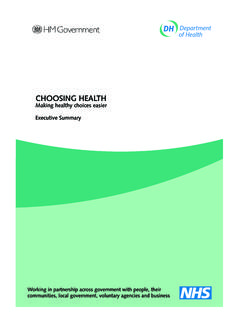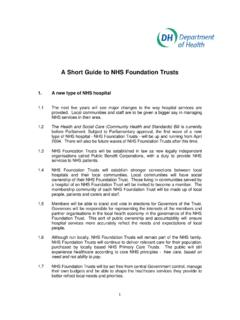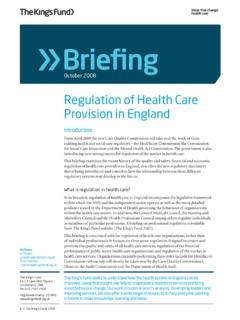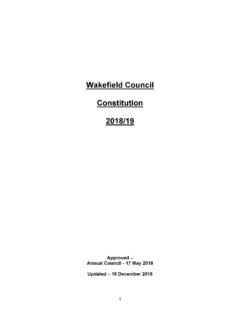Transcription of Delivering the NHS Plan - nhshistory
1 Delivering the NHS Plannext steps on investmentnext steps on reformApril 2002 Presented to Parliament by theSecretary of State for HealthDelivering theNHS Plannext steps on investmentnext steps on reformPresented to Parliament by the Secretary of State for HealthBy Command of Her MajestyApril 2002Cm 5503 Crown Copyright 2002 The text in this document may be reproduced free of charge in any format ormedia without requiring specific permission. This is subject to the material notbeing used in a derogatory manner or in a misleading context. The source of thematerial must be acknowledged as Crown copyright and the title of the documentmust be included when being reproduced as part of another publication or enquiries relating to the copyright in this document should be addressed to HMSO, The Copyright Unit, St. Clements House, 2-16 Colegate, NorwichNR3 1BQ. Fax: 01603-723000 or e-mail: Summary31 Investment + reform = results82 Improving health services133 Expanding capacity154 Incentives for performance185 Choices for patients226 Plurality and diversity257 Strengthening devolution288 Health and social services: one care system319 Changes for the workforce3410 Strengthening accountability3711 Conclusion43 Contents 1 Executive Summary1.
2 There are two arguments that matter on the health service. One, how is it funded?Two, how is it run?2. On the first question, more investment has to be paid for. Either through taxation,social insurance, or private insurance or individual charges. No system is systems are not only more expensive than taxation but leave millionsuninsured, without any cover at all. We believe that the benefit of a universal taxbased model is that it is an insurance policy with no ifs or buts : whatever yourillness, however long it lasts, you get cover as long as you need it. We made ourchoice in the Budget stating plainly that for the NHS to improve faster and tackleyears of underfunding, more money is needed. The Budget now demonstrates how,within our tough public finance rules, we will through general taxation be ableto fund a catch-up period to get us to health spending of of GDP by2008 easily on a par with European levels of health On the second question, we believe that any system for Delivering health care mustuphold the founding principle of the NHS that it is free at the point of use basedon need, not ability to pay.
3 But Chapter 1 describes how the 1948 model issimply inadequate for today s needs. We are on a journey begun with the NHSPlan which represents nothing less than the replacement of an outdated believe it is time to move beyond the 1940s monolithic topdown centralisedNHS towards a devolved health service, offering wider choice and greater diversitybound together by common standards, tough inspection and NHS values. This willbe underpinned by support for staff with more staff, greater flexibility, increasedExecutive Summary 3freedom to do their job even better. The aim: shorter waits, better cancer and hearttreatment, modern but compassionate So we believe in the traditional method of funding, but a completely new way ofrunning the service. It is this reform of the supply sidesystem design which thisdocument focuses Chapter 2 outlines some of the key benefits that this extra health spending willbring. Waiting times for operations will fall from a maximum of 15 monthsnow to 6 months by 2005, and 3 months by 2008.
4 Waits in A&Es and primarycare will fall too. And extra investment in major conditions will cut cancer andcardiac death rates, and improve services such as mental health and for older Chapter 3 summarises some of the key building blocks to growing with latest available headcount figures, there are by 2008 likely tobe net increases of at least 15,000 more GPs and consultants, 30,000 moretherapists and scientists, and 35,000 more nurses, midwives and healthvisitors. Primary care services will be expanded. More elective surgery will takeplace in new freestanding surgical units or diagnostic and treatment centres .Hospital capacity is likely to grow by at least 10,000 more general and acute To help ensure that the large extra investment the NHS is now getting translatesinto capacity growth not inflation, a greater share of the new funding will beused on training new health professionals for the future, and on capitalinfrastructure and modernised information technology rather thancurrent Chapter 4 explains that we are confident that the new national architecture we putin place in our first term is right.
5 There is now broad support for a national bodylike NICE to ensure growing NHS spending is targeted on the most cost-effectivetreatments. There is wide support for National Service Frameworks coveringcardiac, cancer, mental health services and other major conditions. There isconsensus on the need for an external independent inspectorate to assure the qualityof hospitals and primary care on behalf of patients. On the need to spread bestpractice through the NHS Modernisation Agency. And whereas the 1990s werespent debating internal NHS structures, there is now almost complete agreementthat Primary Care Trusts are the right approach. So in just five years, this newarchitecture has radically changed the way the NHS But having got the structures right, Chapter 4 goes on to argue that we now needto introduce stronger incentivesto ensure the extra cash produces improvedperformance. Primary Care Trusts will be free to purchase care from the mostappropriate provider be they public, private or voluntary.
6 The hospital payment4 Delivering the NHS Plan next steps on investment, next steps on reformsystem will switch to payment by resultsusing a regional tariff system of the sortused in many other countries. To incentivise expansion of elective surgery so thatwaiting times fall, hospitals or DTC/surgical units that do more will gain morecash; those that do not, will Chapter 5 underpins the new incentives with the introduction of explicit patientchoice. Over the next four years, starting this year, the Scandinavian system willbe progressively introduced across the NHS in which patients are given informationon alternative providers, and are able to switch to hospitals that have shorter 2005 all patients and their GPs will be able to book appointments at both atime and a place that is convenient to the patient. This might include NHShospitals locally or elsewhere, diagnostic and treatment centres, private hospitalsor hospitals Chapter 6 explains that as NHS capacity grows organically, we will continue to useprivate providers where they can genuinely supplement the capacity of the NHS and provide value for money.
7 This will also expand choice and promote diversityin supply, particularly for elective surgery. New PFI mechanisms, joint venturecompanies, and international providers will all be Devolutionto the frontline will be stepped up, as Chapter 7 describes. TheDepartment of Health will be slimmed down as, for example, in future negotiationsover national employment contracts will be undertaken by NHS employerscollectively rather than by the Department of Health. Instead of all public capitalbeing allocated by the Department of Health from Whitehall, we will considerestablishing an arms-length Bank, controlled by the NHS itself, which wouldinvest capital from the Budget settlement for long term and innovative capacitygrowth and redesign. It will particularly focus on strategic shifts in configuration tomore community and primary care based services. As regards revenue funding,locally runPrimary Care Trusts will hold over 75% of the growing NHS The first NHS foundation hospitalswill be identified later this year, with freedomand flexibility within the new NHS pay systems to reward staff appropriately, andwith full control over all assets and retention of land sales.
8 We will explore optionsto increase freedoms to access finance for capital investment under a prudentialborrowing regime modelled on similar principles to those being developed forlocal Chapter 8 makes the case for a radically different relationship between health andsocial services, particularly to improve care for older people. As the Wanless Reportsuggests, we will legislate to make local authorities responsible for the costs ofhospital bed blocking. Rather than imposing structural reorganisation or nationallyringfenced budgets, this scheme means that social services departments will beExecutive Summary 5incentivised to use some of their large 6% real annual increases to stabilise the carehome market and fund home care services for older people. There will be matchingincentive changes on NHS hospitals to make them responsible for the costs ofemergency readmissions, so as to ensure patients are not discharged As well as growing the numbers of health professionals, there need to befundamental changes in job design and work organisation.
9 Chapter 9 setsout how this requires new contracts for GPs, consultants, nurses and other new NHS pay system will allow greater allowance for regional cost of livingdifferences, and free local employers to design new jobs breaking down traditionaloccupational demarcations. In seeking to expand the size of the healthcareworkforce, a careful balance will be struck between the need to pay staff competitiverates in tight labour markets, and the need to ensure productivity gains on a parwith the wider economy. Staff will be supported to continue life long Given UK health capacity constraints, there are difficult judgements on the speedof funding increases. Too slow, and we miss the opportunity to improve the nation shealthcare, with the risk that people simply give up on the NHS. Too fast, andinvestment might produce input price inflation, rather than improved output andresponsiveness. On best advice the Government has decided that is theoptimal level of real NHS growth in England over the next five years.
10 Higher thanthat would be unlikely to expand healthcare capacity any faster. Lower than thatwould mean an excessive and growing gap between supply and demand. But theGovernment is determined to ensure that additional funding is backed byindependent oversight of how the resources are being used, to ensure theydeliver the intended Chapter 10 therefore describes how at a local level, PCTs will be required to publishprospectuses, accounting to their local residents for their spending decisions, therange and quality of services, and explaining the increasing choices that patientswill At a national level, legislation will be introduced to establish a new toughindependent healthcare regulator/inspectoratecovering both the NHS andthe private sector, with a new Chief Inspector of Healthcare not appointedby Ministers and reporting annually to Parliament. An equivalent body will becreated for social In summary the NHS is now on a stable financial footing and can face the futurewith confidence: with the NHS Plan in place; investment and reforms beginning toshow results; power shifting to the NHS frontline.









